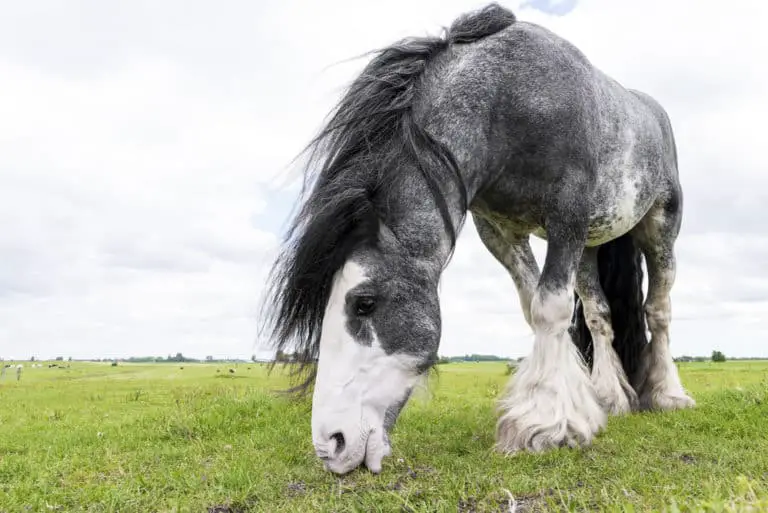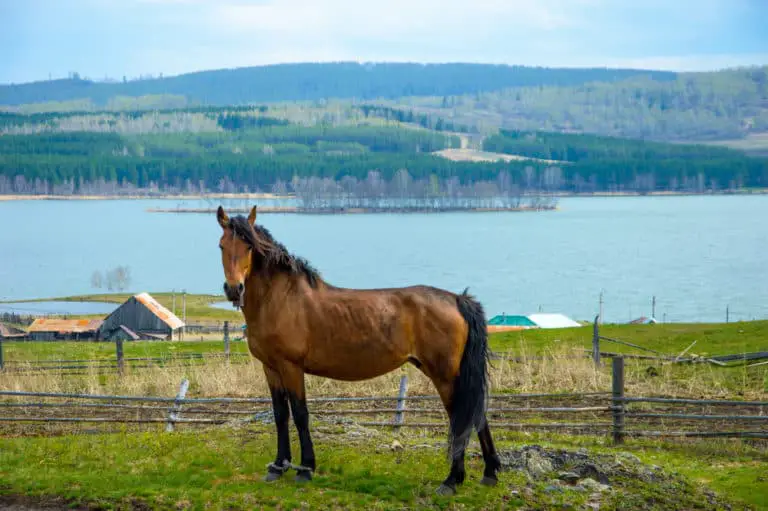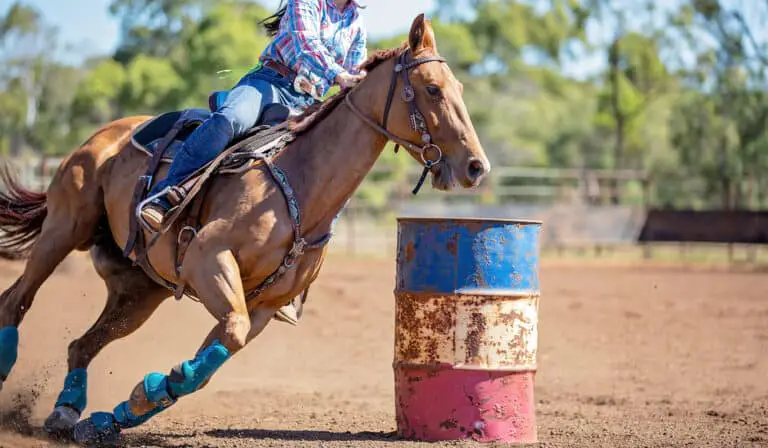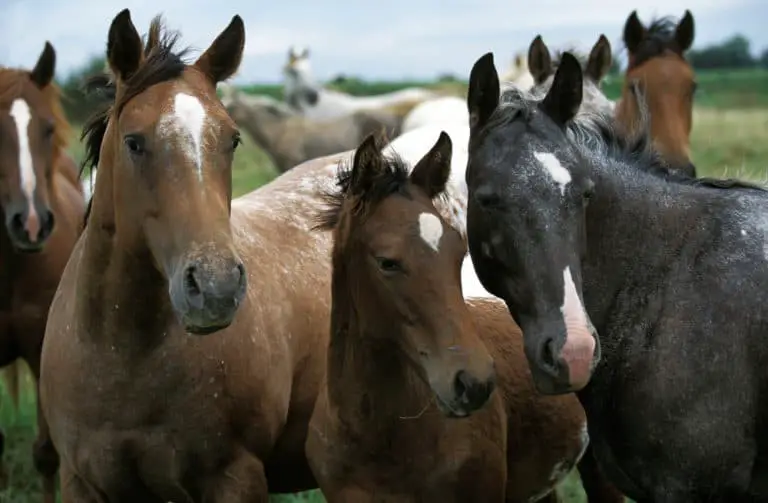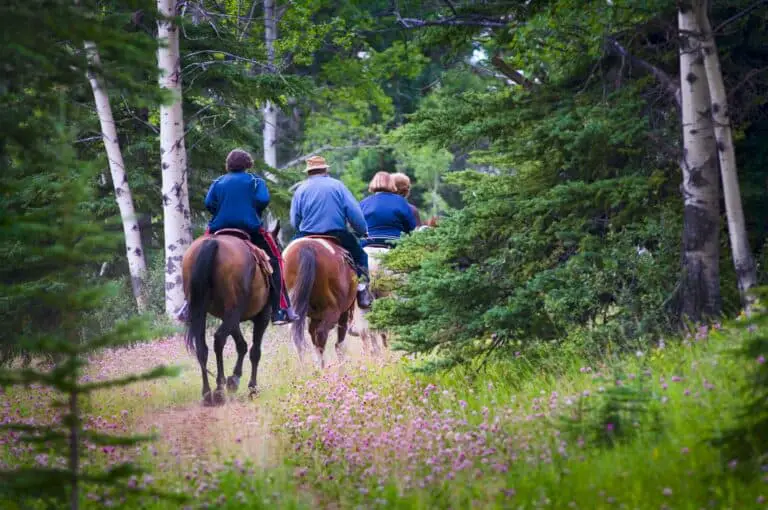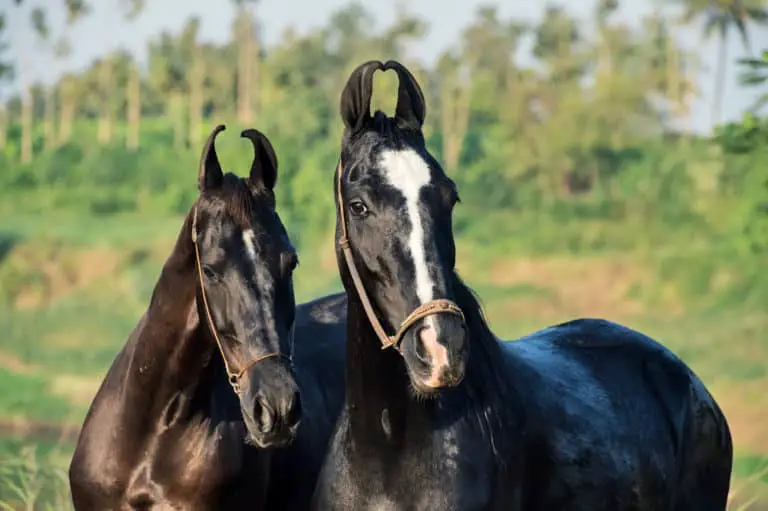Percheron Horse: Care, Cost & History (2025)
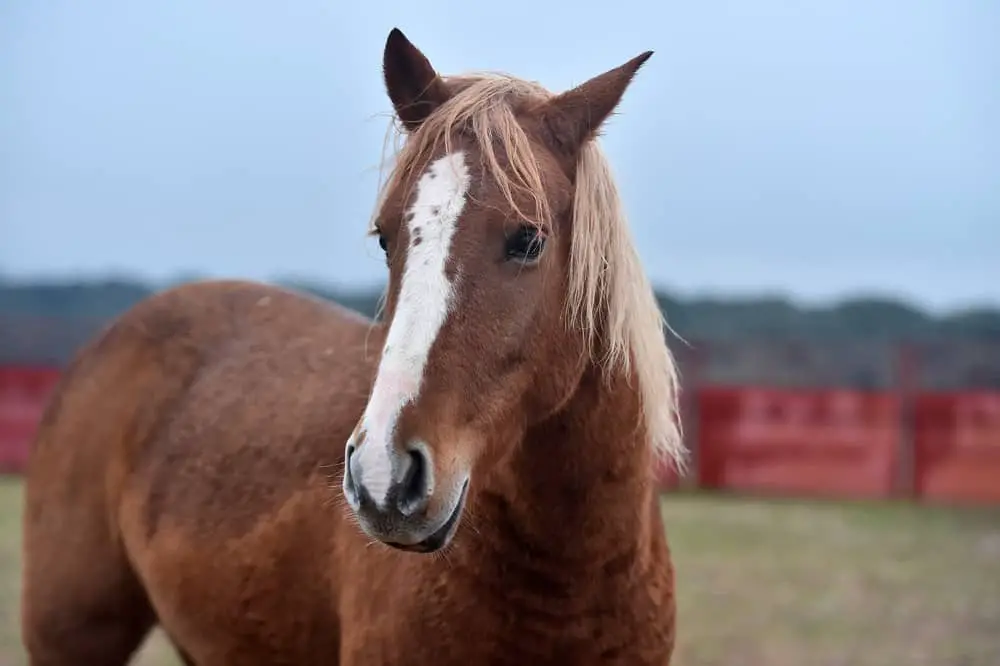
The Percheron horse is a famous draft horse breed originating from France. They are considered one of the most elegant horse breeds. The big horses quickly rose to fame due to their unique features and great personality all around the world. In addition, these majestic French draft horses are known for their intelligence and willingness to perform.
Breed: Percheron Horse
Adult Weight: 1,100 to 2,600 pounds (500 to 1,200 kg)
Adult Height: 15.1 – 18.1 hands (61 to 73 inches)
Origin: France
Use: Draught, Farming, Pulling, Pleasure
Colors: Black, grey
Features: Large size, Muscular body, small ears
Lifespan: 30 – 40 years
Character: Gentle, with solid nerves, willful
Gait: Elegant, steady
Best for: All levels of riders
- Characteristics
- Percheron Horse Care
- Percheron Horse History
- Modern Percherons
- Cost and Ownership
- Buying a Percheron
- Similar Breeds
Percheron Horse Characteristics
Percheron horse characteristics interestingly vary in the countries where this breed is bred. France has the most strict rules when it comes to breeding standards.
Still, they are easy to identify since the species has a distinctive look. Percheron Horses are muscular and big draft horses (1). The Percheron horse head is characterized by small ears, a broad forehead, and they have a straight profile (1).
Size
The accepted Percheron horse height to register a horse of this breed in the studbook is between 15.1 to 18.1 hands (61 to 73 inches) (1). This is the range that the breeding association of France will accept.
The accepted Percheron size can be slightly smaller in the US, with a maximum height of 16.2 and 17.3 hands (66 and 71 inches).
Percheron horses are pretty tall, typical for a draft horse breed. The Percheron Horse can sometimes even be taller than a Clydesdale horse, which is one of the tallest horse breeds worldwide.
Weight
The registry barriers for Percheron horse weight are different in the US and France. France will register Percheron horses in the studbook with 1,100 to 2,600 pounds (500 to 1,200 kg) (1). The United States of America accepts a weight range from 1,900 pounds (860 kg) – to 2,600 pounds (1,200 kg).
Great Britain makes a standard breeding difference between the sexes of a Percheron Horse when it comes to weight. Therefore, 2,000–2,200 pounds (910 –1,000 kg) is the average standard weight for a Percheron stallion and 1,800–2,000 pounds (820 –910 kg) for Percheron mares (2) in Great Britain.
Colors
The beautiful Percheron horse mainly has a black or grey coat (2). The French studbook will accept no other colors. This is different in the USA. The US studbook accepts black, grey, chestnut, bay sorrel, and roan as official Percheron horse colors (3).
Interestingly, some Percheron horses are born with a black coat and slightly fade into grey-colored horses within time. But this will not happen with every black-colored Percheron foal.
The rarest Percheron horse colors are roan and sorrel in the US. Studbooks accept small white markings, but the studbook will not recognize an excess white coat (3).
Temperament
Percheron horse temperament can be described as calm and spirited. The Percheron breed is intelligent and keen to work and perform for its owners (1). One notable difference to other draft horse breeds is their spirit since their personality can sometimes get fiery.
Some say this stems from their ancestors, used as war horses. Furthermore, Percheron horse behavior is characterized by their ability not to spook easily and their level-headed attitude (1).
The Percheron is an excellent horse for beginners since they will tolerate beginners’ mistakes. In addition, their alertness makes them great companions when riding out.
Percheron Horse Care
Given their size, the care you have to provide for a Percheron Horse can slightly differ from lighter horse breeds. Percherons can be prone to health problems, need a dry shelter, and need more space than your average horse. To make sure the Percheron horse lifespan can be as long as possible, one needs to prioritize the care.
Diet and Nutrition
The Percheron diet mainly consists of a variety of pastures. The tall horse breed is used for grazing through the lush green grass (4). Provide them with high-quality hay and fresh water at all times as well (4).
If your Percheron Horse is very active, working on a farm or pulling a carriage, you need to add some grain to their daily feed as well (4).
In addition, it is recommendable to give your Percheron a nice and fresh carrot once in a while and to provide them with a salt block to lick on. The salt block provides horses with minerals (4).
Health Problems
Generally speaking, the Percheron Horse is a sound equine breed with good fitness and health. But like with many other draft horses or heavy horses, the Percheron draft horse is prone to develop some genetic problems (5). This breed’s most common congenital disease is the equine polysaccharide storage myopathy (EPSM) (5).
This genetic disorder is common in heavy horses and damages their muscle tissues. EPSM occurs when a Percheron Horse cant process or use the energy from starchy grains (5). This leads to a tie-up of the Percherons muscle tissue, which gets damaged as a consequence (5).
Grooming
Percheron grooming is one of the topics where the tall draft horses will be demanding. The French horse comes with a lot more body mass than an average light horse breed, and that body mass needs to be cared for. This means more coat to brush, more giant hooves to pick, and a larger stable to clean (6).
To clean it from small particles, you should brush your Percherons coat at least every 1-2 days (6). Pick the hooves of your gentle giant at least once a day as well (6).
Use a Curry Comb to remove more severe dirt and grease from the coat and stimulate the blood flow (6).
Percheron Horse History
The Percheron horse history is exciting and mysterious. Even though we know that the breed has its origin in France, nobody knows where their ancestors are from (7).
Most of the historical records of past Percheron horses are from the UK, France, and the US. Those countries showed the most significant demand for Percheron horses throughout history (7).
Origin
The Percheron horse origin is located in the Huisne River Valley in France, part of the former Perche province back then. The Perche province gave the gigantic horse breed its name (7).
Even though there are many speculations and theories about the ancestors of the Percheron horse, we do not precisely know. Some say their ancestors lived sometime after 496 AD, and mares were captured by the Merovingian king Clovis I from the Bretons (7).
Others swear the Percherons ancestors have been brought from Spain by Moors around the 8th century, and those were Andalusian cavalry stallions (7).
Historic Development
Since the 17th century, we have known about the “younger” ancestors of the Percheron horse. By then, the Horses from Perche were a bit smaller than our modern Percheron, standing at 15-16 hands only (7).
French paintings from the Middle Ages frequently show French kings sitting on grey draft horses, the ancestors of the Percheron horse. The frequency of those paintings indicated that Perche Horses were more often grey than black back then.
They have been used as war horses and diligence horses in Middle Age France (7). After the wars ended, the Percheron was used for farming and heavy hauling work. This explains why they have been bred to be even more heavy and muscular like they are today (7).
Notable Percheron Horses
Even though the Percheron might not be the best-known horse breed globally, there are many famous Percheron horses throughout the world. Some came to dame through a famous Percheron horse pedigree, others are an attraction of a theme park, and some even got adopted by Hollywood movie stars.
Jean Le Blanc – The saviour
When Percheron Horses weren’t used as war horses anymore and retired from the battlefield, they were used for agriculture mainly. When gasoline became very affordable, the breed almost went extinct and was saved by the most famous Percheron stallion, Jean le Blanc. Jean Le Blanc was foaled in 1823 at Mauvres-sur-Huisne. Mauvres-sur-Huisne is a stud to which all of today’s Percheron bloodlines can be directly traced back.
March Viking
March Viking was a beautiful grey Percheron stallion who lived in the 1930s. He was one of the most excellent Percheron stallions. March Viking was foaled in England in 1929 by H.H. Truman of March. Don’t miss out on pictures of March Viking; he was just Percheron perfection.
Pecas – Brendan Frasers Percheron
You probably know and adore the actor Brendan Fraser from “The Mummy” movies and “George in the Jungle.” The Hollywood actor adopted the horse from the set of Texas Rising and named the grey Percheron gelding “Pecas.” Pecas and Fraser’s son, who has autism, became close friends and live their best lives.
Myths and Legends
The biggest myth of the Percheron horse is its true origin. Nobody knows who the ancestors of this breed are, but many theories and legends surround this topic. Percheron horse legends mainly occur in the US and France, where the breed has always been popular.
Invasion of Brittany
One legend about Percheron horses speculates on their relatives and origin once more. A legend tells that the elegant Percheron horse breed is related to the Boulonnais horse. Boulonnais Horses were used for the Roman invasion of Brittany.
Captured from the Muslim Caliphate
Another legend regarding the Percherons horse origin claims that the horses have Arabian blood. It is said that Charles Martel captured Arabs and Barbs after his victory over the Muslim Umayyad Arab Caliphate at Poitiers in 732 AD. Allegedly he brought the captured horses home to breed them to the Percheron warhorses of Europe.
Medieval Fights
Due to their enormous strength and braveness, the Percheron horse was used in medieval fights. Such fights were mainly jousting and lance combat. Even though horses are flight animals and their nature and instincts tell them to run away when danger occurs, numerous legends tell us about the brave Percheron triumphing in jousting and lance combat.
Modern Percheron Horses
The most exciting fact that describes the modern Percheron horses is their use in Disneyland. Percheron horses make up 30% of the horses who pull the carriages in the world-famous theme park.
Their calm mind and a high tolerance for crowds and noise make them the ideal candidate for this job. Different types of Percheron horses pull carriages in Disneyland Paris and Disneyland Orlando in Florida.
Percheron horses are best represented in the US and France, with the US having the highest population of Percheron horses (8). In 2009 approximately 2,500 horses have registered each year in the United States alone. The global population of Percherons exceeded 32,000 horses in 2013 (8).
Breeding
Percheron breeding is still most popular in the US and France (9).
France still appreciated the historical bonds to the French breed, but the US had a higher demand for the French drafting horse.
Percheron horse breeding focuses mainly on their versatile use for riding and pulling carriages. However, their height and musculus body type are still among the studbook’s most important breeding goals (9).
The first studbook for Percheron horses was founded in 1893 in France. More societies followed from the US, Germany, and Canada.
Population
At two points in history, the Percheron horse almost went extinct (8). The first time of their near extinction was in the 19th century. Jean Le Blanc was the Percheron stallion who was bred intensively and is the ancestor of almost every Percheron to this day (8).
The second time of near extinction occurred when the Second World War ended. The demand for Percheron horses for their use in agriculture decreased since gasoline became cheap and mechanization took over. The Percheron horse population was stabilized and saved by some passionate breeders who helped to achieve the stable population of Percherons nowadays.
Uses
Luckily the days for the Percheron horses being used for wars is over. Of course, they are still used for pulling carriages or farming, but modern machinery makes their jobs a little less demanding than a hundred years ago.
The Percheron horse uses are incredibly versatile for a draft horse breed (1). Usually, draft horses are not too great riding horses and are not commonly used for dressage, showjumping, or pleasure riding. However, this is not true for the Percheron horse (1).
Percheron horses are excellent riding horses, and they compete in every equestrian competition one can imagine. The Percheron horse gait is incredibly elegant despite its vast proportions (1). Their willingness, calmness, and ability make them kind-hearted companions.
Percheron Horse Prices
When it comes to the Percheron horse price, many people only think about the actual purchase price of the horse.
But owning a horse comes with monthly and regular costs that can’t be avoided or skipped.
Once you have purchased a Percheron Horse, you will need to pay for monthly ownership costs, including boarding, feed, vet care, and hoofing care.
Purchase Price
Even though the Percheron Horse is not considered a rare or expensive horse breed, one might think this is a reason for them being super cheap. Percherons are not ultimately affordable compared to other high-cost breeds like Thoroughbreds.
As with all horse breeds, the pedigree, health status, Percheron horse training, and its physical data determine the purchase price of Percheron horse.
An average Percheron horse costs between $1,000 to $10,000 (10). The vast price difference is due to the fact that, on the one hand, Percherons are still being used as farm horses. This is why they are sometimes sold for relatively low prices through farmers (10). On the other hand, Percherons can also participate in the prestige disciplines of dressage and show jumping. This accelerates the price to $20,000 for well-acclaimed and winning Percheron horses (10).
Ownership Costs
It is essential that when you decide to buy a Percheron horse, you are aware of the Percheron horse cost of ownership that comes with owning your gentle giant. That is aside from the initial Percheron price.
The monthly costs of ownership should be considered: board, feed, veterinarian care, and hoof care are just some of the regular costs, which can easily be as high as $1,000 a month.
Board
The Percheron horse board cost will be around $250-300 monthly. If you pay for full board, which includes regular vet care, feed, hoof care, and exercising your horse, the monthly boarding cost will be higher, starting at $300, than just paying for putting your horse in a stable, which can cost as little as $150 a month.
Be aware that some stable owners might even demand higher prices due to the large size of Percheron horses.
Feed
When it comes to Percheron horse feed cost, you have to pay for high-quality hay. A bay of hale will cost you around 2$-$4. Percheron horses do, in fact, not eat much more hay than a light horse breed since their energy requirements are lower (11).
A Percheron horse will need about 15-30 bales per month. If your horse is active in pulling or farming activities, it needs more energy, and you have to add some grain feed which is around $13 for a bag that lasts about 1-2 weeks.
Veterinary Care
The Percheron horse veterinary cost will be around $200-$300 (11). These costs cover annual vaccinations, deworming for 12 months, and teeth floating once or twice per year. Anything unexpected like injuries, inflammations, or colics is not included in this estimate (11).
Keep in mind that you have to watch out for EPSM. If your horse is developing or suffering from EPSM, you will face many more unexpected costs.
Hoof Care
The Percheron horse hoof care cost is regular since you need to regularly shoe or trim their hooves. Trimming your horses’ hooves will cost around $20-$35 for each trim (12). Shoeing your horse will cost you more than twice as much – approximately $80. This brings the annual costs to anything from $150 to over $1,000, depending on your Percherons hoof care (12).
Buying a Percheron Horse
If you have decided to buy a horse of the Percheron breed, you already know that you will need a lot of space and savings for your majestic horse.
Make sure to meet your Percheron before the purchase. The horse’s spirit should match your energy and what you are looking for. Your Percheron foal or adult horse should always come with documentation and health certificates.
Is the Percheron Horse Right for You?
Percheron Horses are stunning horses with the French chic one would expect. The rider who wants to sit up high and engage in pleasure treks riding a Percheron horse through nature is well accompanied by the brave French Horse.
Someone who owns a smallholding and needs some old-school help with their chores will be happy with owning a Percheron horse as well. A Percheron Horse will make for a gentle and calm companion, and even your kids are safe around the gentle giants.
Even if you are a professional and competitive rider, the Percheron Horse might be an excellent choice for you. Due to their versatile capabilities, they make great dressage or showjumping horses.
How to Buy a Percheron Horse?
If you are keen on buying a Percheron horse, you will need to look for a renowned and recommended Percheron breeder in your area. Visit the breeder to get an idea of how the Percherons are held and brought up there.
Look out for cleanliness in the stables, how many horses there are on the farm, and how they interact with their current owner.
Does the relationship between owner and horse seem loving and trusting or distant?
You should interact and ride the Percheron of your interest and talk with the breeder about the traits and characteristics of the horse to see if it is a good fit for you.
Similar Breeds to Percheron
Some similar breeds to Percheron Horses, who share some of their outstanding features. Percheron breed alternatives are the Clydesdale, the Belgian, and the Friesian Horse.
Some of those breeds are slightly taller, come in more coat colors, or are even more suitable for dressage or showjumping and therefore offer good alternatives to a Percheron Horse.
Clydesdale
The Clydesdale is known to be one of the tallest breeds of horses. The main distinctive difference between a Clydesdale and a Percheron is the feather around Clydesdale’s legs. Clydesdales tend to be taller as well and are best suited for driving.
Friesian
The Friesian Horse is a beautiful black horse breed similar to the Percheron breed when it comes to size and uses. However, Friesians are a little more fancy compared to a Percheron Horse. They have a shiny black coat, voluminous manes, and feathers on their legs. In addition, they have a more flashy knee action and a higher head than a Percheron.
Belgian
Some say it is tough to tell a Belgian and a Percheron apart despite their coat color. Belgian Horses have red-brown coats with light blonde manes. They have tails with chestnut, sorrel, or blonde coats and are therefore differently colored compared to a Percheron Horse.
FAQ
What is a Percheron horse?
The Percheron Horse is an equine breed from France. They are draught horses and have versatile uses.
What does a Percheron horse look like?
Percheron Horses are mainly black and grey for their coat colors. They have a draught body type with a muscular build and small ears.
How did the Percheron horse get its name?
The Percheron Horse was named after the French province Perche. Perche is said to be the origin of the Percheron Horse breed.
Can you ride a Percheron horse?
Yes, you can. Percheron Horses are excellent riding horses and suitable for all adult riders if they have been adequately trained.
Are Percheron horses good for beginners?
Yes, a trained Percheron horse can be a good horse for beginners. The breed is calm and level-headed, making them gentle with novices who still make some mistakes while riding.
How tall is a Percheron horse?
Adult Percheron horses stand between 15.1 – 18.1 hands, 61 to 73 inches.
How much does a Percheron horse weigh?
The average Percheron Horse weighs between 1,100 to 2,600 pounds (500 to 1,200 kg). The weight can differ for every individual, of course.
How big is a Percheron horse?
Percheron Horses are draught-type horses, and therefore they are very tall. They are not as tall as a Clydesdale but still bigger than a light horse breed.
How much does a Percheron horse cost?
The price of a Percheron horse will mainly be dictated by the training the horse has received, their pedigree, and its outer appearance. You can pay as little as $1,000 or up to $10,000 for a champion stallion.
How much does a Percheron horse ownership cost?
The ownership of a Percheron horse can easily cost you up to $1,000 each month. The costs depend on your boarding (full or partial?) and the area you live in. The average cost is around $300 each month.
How long do Percheron horses live?
Percheron Horses can get really old. They live on average between 30-40 years if you care well for them.
How fast can a Percheron horse run?
Percheron Horses can be quite fast for their bulky build with up to 50 mph.
How much can a Percheron horse pull?
Pulling is one of the main traits a Percheron has been bred for, and this is why they can pull up to 1,900 – 2,100 lbs. This is quite a lot.
How much can a Percheron horse carry?
A Percheron which weighs averagely around 1,800-2,000 pounds, can carry up to 360 pounds.
At what age is a Percheron horse full grown?
Most draft breeds do not stop growing until they are eight years old. This is also true for the Percheron Horse breed.
What are Percheron horses used for?
The use of Percheron Horses is incredibly versatile for a draught horse breed. They are used for pulling, carrying, farming, logging, and even Percheron dressage and show jumping. They are also great riding horses and are therefore often used for pleasure.
References
- Les Haras Nationaux. 2011. Reglement Du Stud-Book Du Cheval Percheron. Link
- British Percheron Horse Society. 2022. Characteristics of the British Percheron. Link
- Percheron Horse Association of America. 2022. Percheron Disposition and Characteristics. Link
- Kentucky Equine Research. 2011. Nutritional Management of Draft Horses. Link
- Forage Plus Talk. 2022. EPSM, a Muscle Disorder. Link
- Fédération Équestre Internationale. 2021. Breed Profile. Link
- Percheron Horse Association of America. 2022. The Origin and History of the Percheron Horse. Link
- The Livestock Conservancy. 2022. Percheron Horse. Link
- Britannica. 2022. Percheron. Link
- Ehorses. 2022. Percheron Prices. Link
- Una McCaffrey, Independent. 2002. The Cost of Owning a horse. Link
- The Horse. 2014. Poll Recap: Hoof Care Costs. Link

